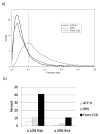Comparison of the Framingham and Reynolds Risk scores for global cardiovascular risk prediction in the multiethnic Women's Health Initiative
- PMID: 22399535
- PMCID: PMC3324658
- DOI: 10.1161/CIRCULATIONAHA.111.075929
Comparison of the Framingham and Reynolds Risk scores for global cardiovascular risk prediction in the multiethnic Women's Health Initiative
Abstract
Background: Framingham-based and Reynolds Risk scores for cardiovascular disease (CVD) prediction have not been directly compared in an independent validation cohort.
Methods and results: We selected a case-cohort sample of the multiethnic Women's Health Initiative Observational Cohort, comprising 1722 cases of major CVD (752 myocardial infarctions, 754 ischemic strokes, and 216 other CVD deaths) and a random subcohort of 1994 women without prior CVD. We estimated risk using the Adult Treatment Panel III (ATP-III) score, the Reynolds Risk Score, and the Framingham CVD model, reweighting to reflect cohort frequencies. Predicted 10-year risk varied widely between models, with ≥10% risk in 6%, 10%, and 41% of women with the ATP-III, Reynolds, and Framingham CVD models, respectively. Calibration was adequate for the Reynolds model, but the ATP-III and Framingham CVD models overestimated risk for coronary heart disease and major CVD, respectively. After recalibration, the Reynolds model demonstrated improved discrimination over the ATP-III model through a higher c statistic (0.765 versus 0.757; P=0.03), positive net reclassification improvement (NRI; 4.9%; P=0.02), and positive integrated discrimination improvement (4.1%; P<0.0001) overall, excluding diabetics (NRI=4.2%; P=0.01), and in white (NRI=4.3%; P=0.04) and black (NRI=11.4%; P=0.13) women. The Reynolds (NRI=12.9%; P<0.0001) and ATP-III (NRI=5.9%; P=0.0001) models demonstrated better discrimination than the Framingham CVD model.
Conclusions: The Reynolds Risk Score was better calibrated than the Framingham-based models in this large external validation cohort. The Reynolds score also showed improved discrimination overall and in black and white women. Large differences in risk estimates exist between models, with clinical implications for statin therapy.
Conflict of interest statement
Figures



Comment in
-
How accurate are 3 risk prediction models in US women?Circulation. 2012 Apr 10;125(14):1723-6. doi: 10.1161/CIRCULATIONAHA.112.099929. Epub 2012 Mar 7. Circulation. 2012. PMID: 22399534 No abstract available.
References
-
- Executive Summary of the Third Report of the National Cholesterol Education Program (NCEP) Expert Panel on Detection, Evaluation, and Treatment of High Blood Cholesterol in Adults (Adult Treatment Panel III) JAMA. 2001;285:2486–2497. - PubMed
-
- Ridker PM, Buring JE, Rifai N, Cook NR. Development and validation of improved algorithms for the assessment of global cardiovascular risk in women. JAMA. 2007;297:611–619. - PubMed
-
- Greenland P, Alpert JS, Beller GA, Benjamin EJ, Budoff MJ, Fayad ZA, Foster E, Hlatky MA, Hodgson JM, Kushner FG, Lauer MS, Shaw LJ, Smith SC, Jr, Taylor AJ, Weintraub WS, Wenger NK, Jacobs AK for the American College of Cardiology Foundation/American Heart Association Task Force on Practice Guidelines. 2010 ACCF/AHA guideline for assessment of cardiovascular risk in asymptomatic adults: a report of the American College of Cardiology Foundation/American Heart Association Task Force on Practice Guidelines. Circ. 2010;122:e584–636. - PubMed
-
- Genest J, McPherson R, Frohlich J, Anderson T, Campbell N, Carpentier A, Couture P, Dufour R, Fodor G, Francis GA, Grover S, Gupta M, Hegele RA, Lau DC, Leiter L, Lewis GF, Lonn E, Mancini GB, Ng D, Pearson GJ, Sniderman A, Stone JA, Ur E. 2009 Canadian Cardiovascular Society/Canadian guidelines for the diagnosis and treatment of dyslipidemia and prevention of cardiovascular disease in the adult - 2009 recommendations. Can J Cardiol. 2009;25:567–569. - PMC - PubMed
Publication types
MeSH terms
Grants and funding
- 32105-6/PHS HHS/United States
- N01 WH044221/WH/WHI NIH HHS/United States
- N01 WH042107/WH/WHI NIH HHS/United States
- 32100-2/PHS HHS/United States
- 42129-32/PHS HHS/United States
- N01 WH032115/WH/WHI NIH HHS/United States
- 32108-9/PHS HHS/United States
- HHSN268200960011C/HL/NHLBI NIH HHS/United States
- N01 WH032105/HL/NHLBI NIH HHS/United States
- 32122/PHS HHS/United States
- 32111-13/PHS HHS/United States
- 42107-26/PHS HHS/United States
- 32115/PHS HHS/United States
- N01 WH022110/WH/WHI NIH HHS/United States
- N01 WH032100/WH/WHI NIH HHS/United States
- N01 WH032111/WH/WHI NIH HHS/United States
- N01 WH032122/WH/WHI NIH HHS/United States
- N01 WH032118/WH/WHI NIH HHS/United States
- 24152/PHS HHS/United States
- 32118-9/PHS HHS/United States
- N01 WH032108/WH/WHI NIH HHS/United States
- 44221/PHS HHS/United States
- N01 WH042129/WH/WHI NIH HHS/United States
- N01 WH024152/WH/WHI NIH HHS/United States
LinkOut - more resources
Full Text Sources
Other Literature Sources
Medical

